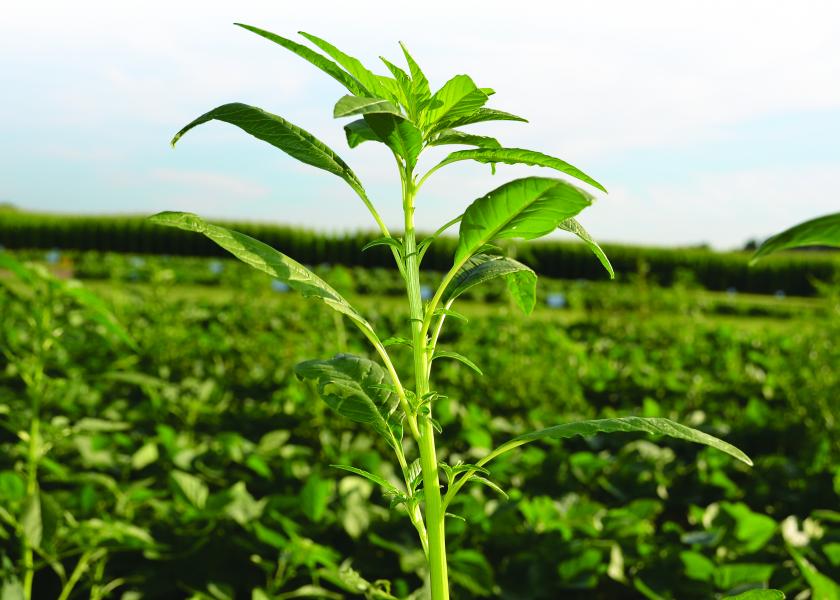How to Manage Weeds in 2020

Its roots dug deep into the soil, its leaves stretched for sunlight to a 9’ stature and it produced hundreds of thousands of offspring in a single season — last year’s waterhemp will still wreak havoc on fields this year. Unchecked, waterhemp can produce more than half-a-million seeds in a single plant, and last year escapes ran rampant with some prevent plant acres having never received control measures.
Get ready for a fight.
“In my Palmer amaranth tour of Iowa, more than three-quarters of the fields had waterhemp escapes that probably weren’t impacting 2019 yield, but they were producing millions of seeds,” says Bob Hartzler, Iowa State University Extension weed scientist. “Non-economic infestations that don’t hurt yield can increase the weed seed bank five- to 10-fold.”
This year, best management practices, hyper-vigilance and a zero-tolerance policy for escapes will be critical to get ahead of weed seed banks. Have a plan, and several back-up plans ready ahead of planting.
“A wise person once told me weeds don’t care how much money you spend, they’ll still be there,” says Brett Craigmyle, Syngenta agronomic service representative. “Guys who tried to save money in the past probably learned that’s not always the best avenue. Create a game plan now and have a ‘B’ and ‘C’ plan in your back pocket.”
Manage Herbicide Carryover Restrictions
Excessive moisture last year means some prevent plant fields, and even some planted fields, didn’t receive herbicide applications until later in the season than normal. That means farmers will need to mind not only increased weed seed banks, but herbicide carryover restrictions, too.
“Carryover won’t be an issue on every acre, but we saw herbicide applications in June that have long-term soil residual,” says Aaron Hager, University of Illinois Extension weed scientist. “Review last year and be aware of the rotation restrictions, some have 10-month rotation intervals, so you don’t want to plant those first this spring.”
Control Winter Annuals
Before you can worry about summer annual weeds, you have to manage any winter annual weeds that might compete in fields.
“So far, this winter doesn’t seem harsh enough to kill winter annuals, so it won’t take long to green up this spring,” Hager says. “It might not make much of a difference in conventional till. The concern should be in no-till situations—get a good burndown.”
Scout for what weeds are present as fields start to green up over the next few weeks. Common weeds include:
- Marestail
- Henbit
- Chickweed
- Mustards
- Cressleaf grounsel
Research what’s in your field and be prepared for glyphosate resistance, especially when marestail is present.
“As soon as things start greening up assess fields and populations. If you have a solid mat of winter annuals, they may be difficult to manage at planting,” Hartzler says. “So, an early pre-plant application, like three to four weeks, ahead of planting would be beneficial — they’ll be easier to kill and won’t have tied up nutrients.”
Apply pre-emergent herbicides
With a bigger weed seed bank in 2020, best management practices will be critical to avoid yield loss and increased weed seeds in future seasons.
“Utilize residual herbicides before planting,” says Eric Riley, Bayer North American selective herbicides technical manager. Residual herbicides reduce the number of weeds exposed to post herbicides, which reduces selection pressure for resistance to those herbicides, he adds.
Your pre-emergent herbicide decision might be the most important weed management decision you make this year. It’s what gets the crop started and sets the stage for how effective post-emergent applications can be.
“Don’t skimp on rates,” says Darren Unland, BASF technical marketing manager. “There are rate ranges, some provide more full-season-type of control while others offer more like three weeks. I suggest you don’t just use the set-up rate but use a robust rate within the label.”
Also, opt for the strongest start possible with pre-emergent herbicides. You might consider altering your planting schedule to manage weeds.
“It’s a more viable option to delay planting in soybeans than in corn because yield is flatter in soybeans than corn when it comes to planting date,” Hartzler says. “It’s an old tried-and-true method to control weeds. Planting is three weeks earlier than it used to be, before we would kill early flushes of weeds as a standard practice — and organic farmers still do that.”
Weeds are easier to kill before the crop is planted, so delaying planting to allow early flushes to be killed by tillage or a burndown herbicide can simplify weed management. It’s more helpful for early-season weeds such as foxtails, giant ragweed and lambsquarters. It might not be as beneficial with Amaranthus species and other late-emerging weeds.
Manage weeds in season
While pre-emergent herbicides with residuals can start the crop off right, it doesn’t last the whole season. As you see escapes starting to sneak through, or before the crop canopies, it’s a good idea to get out with an in-season weed control pass.
“We advocate for residual herbicides in the post emergent application, too,” says Ron Geis, Corteva market development specialist. “Farmers have been using this strategy for 20 years in corn, but not soybeans. We need to start because soybeans don’t shade the row until August in most years and the post herbicide is usually in mid-June.”
Resistance should still be top of mind. Use multiple, effective modes of action to kill problem weeds in fields.
“Treat every field like we have multiple resistances out there,” says Nick Hustedde, FMC technical support representative. “Also think broad spectrum and about species shifts. If you chase a single species with a herbicide, another species is chasing you.”
Don’t let weeds steal from your bottom line in 2020. Start early, scout often and manage weeds effectively.







